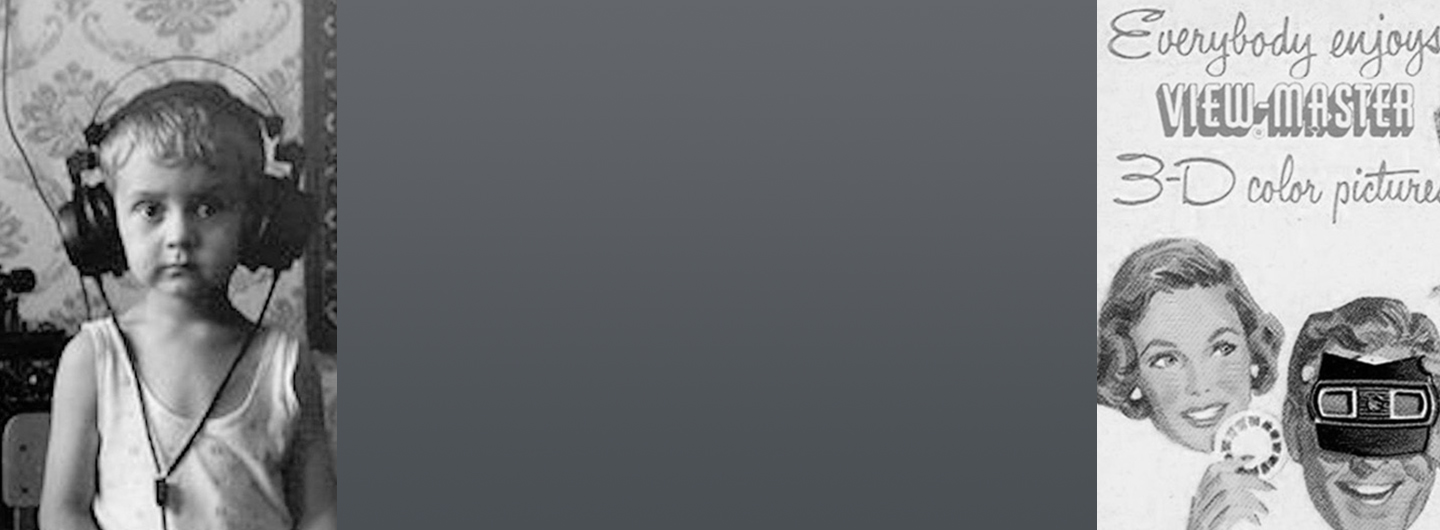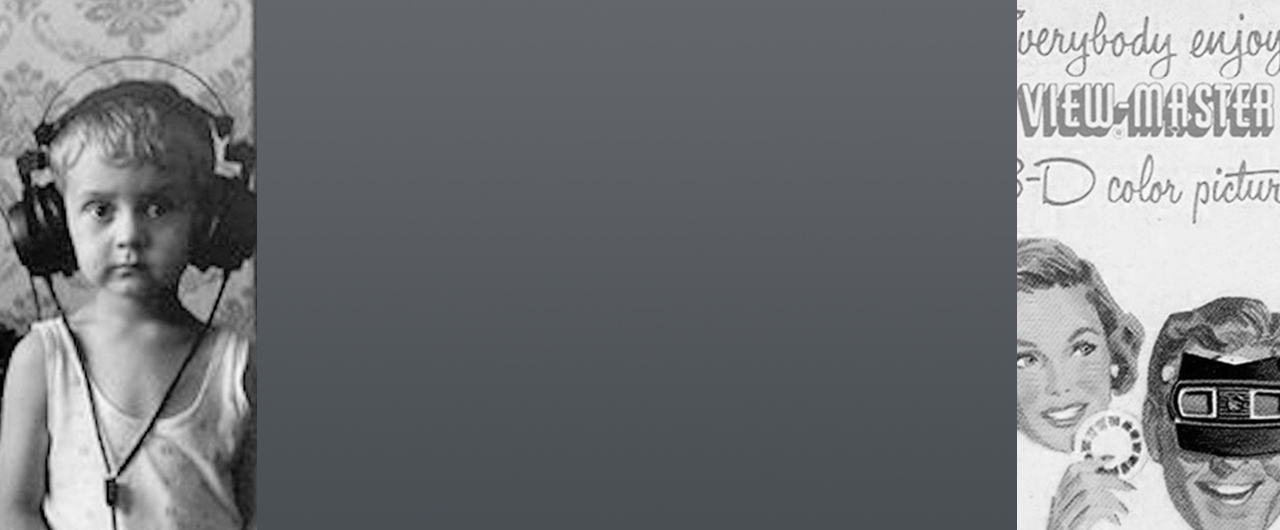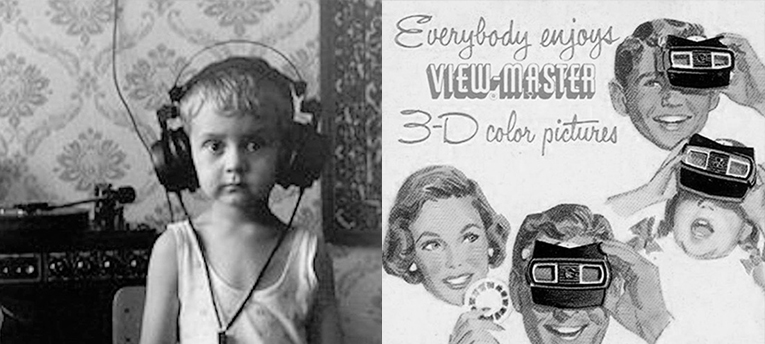





Channels are a way of storing two or more simultaneous streams of information. Human perception often depends on fusing input from multiple streams. Sight, for example, fuses two views of the world for depth perception. Hearing uses our two ears to help localize sound. Our brains combine signals from three types of color receptors to reconstruct the continuous spectrum of light.
There are other applications where it is convenient or necessary to store information in multiple channels. Recording each musical instrument or singer in a separate channel allows mixing the sound as a post-process. In engineering or scientific applications, data acquired from multiple sensors can be stored in channels to preserve simultaneity.






















































































































































The inconvenience…of dragging along over mountain and valley, or of stowing away on steamer or on the cars, a complete miniature operating gallery, has suggested the idea of superseding all this trouble by the discovery of a dry process. (Towler, John.The Silver Sunbeam, Joseph H. Ladd, New York: 1864, in CoOL: Conservation OnLine



















…How charming it would be if it were possible to cause these natural images to imprint themselves durably, and remain fixed upon the paper. And why should it not be possible, I asked myself. (Talbot, Henry Fox, The Pencil of Nature, 1844, p.4.)






The fact that our eyes see slightly different views of the world has long been noted: Euclid wrote about it in AD 280; Leonardo da Vinci described it in his notebooks. But the connection between that disparity and the perception of depth wasn't recognized until the early 19th century. Depth perception was ascribed to other visual cues. It was not until 1832 (announced publicly in 1838) that Sir Charles Wheatstone, with his invention of the stereoscope, demonstrated experimentally that it was the slightly different perspective seen by each eye that gave the sensation of depth.
Wheatstone was a scientist who invented a medium and device in service of his research. He wasn't trying to create something useful or entertaining. (For a similar example, see Étienne-Jules Marey, an inventor of cinema, who made his contributions in order to understand human and animal locomotion.) Others, including David Brewster, Louis-Jules Duboscq and Oliver Wendel Holmes, refined the stereoscope and made it practical for everyday use. By the mid-Victorian era, stereoscopes were a fixture in middle class parlors.
Although Wheatstone's original stereo pairs were drawn by hand, photography soon came to dominate the creation of 3D views. Non-photographic stereoviews still had a place, however, particularly for scientific or mathematical diagrams and for comics and cartoons. Eventually, computers made it possible to generate complex, highly realistic non-photographic 3D views.
Drawing stereo pairs by hand is difficult (though not impossible (Scroggins 2025) ) for all but the simplest geometries. What was needed was a way to capture images from real life. Opportunely, the introduction of photography in 1839 followed Wheatstone's invention by only one year. Wheatstone understood the potential immediately and arranged in the early 1840s to have stereo pairs made for experimental use with the talbotype and daguerreotype processes. These were separate images, as required by Wheatstone's reflecting stereoscope, which was a cumbersome tabletop instrument intended for scientific use.
In 1849, Sir David Brewster introduced a handheld lenticular (lens-based) stereoscope that allowed stereo images to be mounted side by side on a card, a convenient format that became the standard. After Brewster visited Louis-Jules Duboscq, an optician and instrument maker in Paris in 1850, Duboscq made improvements to the Brewster viewer and began producing stereo daguerreotypes.
In 1851, Duboscq had a booth in the Crystal Palace at the Great Exposition in London. There, Brewster showed Queen Victoria a Duboscq stereoscope. Her appreciative reaction set in motion a craze for stereoviews that spawned a new industry (according to Brewster, at least—it turns out he was the only witness and there is, according to Denis Pellerin, no corroborating evidence (Pellerin 2025) ). Nevertheless, stereoscopy did take off in the 1850s as entertainment for the home and since then virtually every photographic process invented has been used to make stereoviews, up to and including digital photography.
The storage of visual color information requires three variables at every point on the image rather than a single measurement of light intensity. The number of channels is multiplying, which is most obvious in the Kromogram below, which uses six images of the same scene to store direction, depth and color.
With some photographic processes, including daguerreotype, ambrotype, tintype, and reversal film, the image captured in the camera is viewed directly. Often, however, taking a photograph produces a negative in the camera, which requires additional work to turn into a viewable positive image or print. Producing a photographic print (as opposed to printing photomechanically) exposes silver-halide coated paper to light passed through the negative. The dark areas in the negative block light, resulting in bright areas in the positive print. Multiple prints can be produced from a single negative.
The last example below is slightly different: a print from a digital photograph. There is no negative. However, it is still a photographic print in that it uses silver-halide based photo paper (Kodak Professional Digital Paper) exposed using a digital laser printer. The resulting print must be developed similarly to a non-digital print.
Unlike photographic printing, photomechanical involves no photochemical reactions. Instead, the image is copied by applying ink to paper (or some other base).
The standard 3.5 x 7 inch format for stereoviews was adopted early—stereo daguerreotypes of this size were produced from the early 1850s. There were a number of variations within this framework.
Transparent stereoviews were first made possible by the Langenheim brothers in 1848 with their technique for printing photographic positives on glass. Their halotype process was used almost immediately for both magic lantern slides and stereoviews. In the case of stereoviews, one advantage was that holding a transparent image up to a bright light source offered greater dynamic range than possible with a printed card.
Celluloid stereoviews are usually considered stereo slides, but these are a bit different: the mounted full-size view is made to be viewed in a standard stereoviewer and the stereo dental x-ray is an unmounted piece of celluloid.
Stereroviews provided plenty of opportunities for special effects. Sir David Brewster came up with the idea of creating ghosts in photographs by a kind of double exposure. Techniques of back lighting familiar from peep boxes could also be applied to stereoviews. The parameters of binocular vision could be tweaked by changing the distance between the "eyes"—widely separated viewpoints create a hyper-stereo effect that can make a cityscape look like a model.
The Keystone Company began selling stereoviews and viewers for the diagnosis and treatment of problems with stereovision in 1932. Keystone went out of business in 1972, but polarized stereo images are still manufactured and sold for that purpose.
In addition to the range of standard sizes for stereoviews, various manufacturers had their own formats.
Stereoviews were a popular form of peepshow in arcades from the late 1800s into the 1930s, alongside mutoscopes, muscle testers, player pianos and similar devices. The machines typically held a number of cards attached to a drum or belt, which for a penny allowed the viewer to cycle through 20 or so views. Each machine held several sets of views, so the viewer had to keep inserting pennies to see them all. Most of the views shown here have notches that allowed them to be attached to the mechanism.
Stereoviewers, mutoscopes and other kinds of peep shows had reputation for racy content in the form of women in various degrees of undress. Most of these would be considered mild today, but at the time, exhibitors were sometimes prosecuted. Other forms of content included humor, celebrities and travel.


A slide, in this context, is a photographic transparency on film, normally mounted in a frame of cardboard, plastic or metal. The images are typically 35 mm or 16 mm, but other sizes, particularly panoramic, also exist.





Cards containing six or more stereo pairs were a convenient way to view multiple images. They typically told a story or collected pictures of a tourist destination.
The View-Master disc is a cultural icon. In one form or another, View-Masters have been continuously marketed since the format was invented in 1938 by William Gruber and Harold Graves of Portland, Oregon. They've offered almost every type of subject imaginable, from children's entertainment to erotica, as well as travel, education, military, marketing, movie tie-ins and cartoons.
The View-Master concept was copied all over the world. Clones of varying quality were produced in Italy, Spain, Russia, Eastern Europe, Australia and China. Some were direct copies of View-Master viewers; others had distinctive designs, but the reels were all interchangeable with official View-Master discs.
Many visual media have inspired attempts to add audio. The addition of sound to cinema is the most successful example. Records or cassettes accompanying filmstrips—with a ping to tell the operator to advance the strip—were familiar to anyone who sent to school in the 1960s and 1970s. In 1970,GAF, which owned View-Master at that point, introduced the "Talking View-Master" using small record discs to store the audio. The audio quality left a lot to be desired.
The final version, Tyco's "Talking View-Master 3D," was a View-Master in name only: the stereo pairs were held on a filmstrip in a cassette (see below under "Stereo Filmstrip"). The audio was stored on a solid state chip in the cassette.


Stereo filmstrips interleave stereo pairs on a single unmounted strip of film. Non-stereo filmstrips had been around since the 1890s for projection by magic lanterns. Novelview, in the 1930s, was the first to apply the concept to stereo images.


Stereoviews store two channels of visual information side-by-side, the directions from which light arrives stored in two independent 2-dimensional spaces. Anaglyphs store two images that share the same two-dimensional space. The two images are separated by differences in color instead of location. Different color filters placed in front of each eye the extract the appropriate images. The principle advantage is that the medium doesn't have to be placed inside a viewer. Anaglyph images can be printed in books, magazines or comic books. A viewer can fairly easily be included along with the image in the form of cardboard glasses. Anaglyphs can also be projected.


Polarization is another way to print two images in the same space. Instead of the red/green colored glasses used for anaglyphs, the images are viewed through glasses with the left and right lenses polarized 90 degrees apart. Two transparent images with polarizations matching the glasses are printed on top of each other. Viewed through the glasses, each eye sees only the correspondingly polarized image. Although they have in the past been used for aerial photographs and geometry visualization, they are now most often used by ophthalmologists to test stereo vision.


3D movies store images in a left and right channel. The two channels can be superimposed on the film and differentiated by color (anaglyphic) or by polarization. They can also be separate—either side-by-side, over/under (one above the other) or as two separate strips of synchronized film—and superimposed on the screen when projected through color or polarizing filters. 3D movies have had three cycles of commercial popularity, beginning in the 1950's with movies like Bwana Devil, then again in the 1980's with movies like "Jaws 3D". Avatar set off the third cycle in 2009, which is still underway.


Color photography depends on storing multiple channels of light intensity. When combined, each channel stimulates one of the three types of receptors in the eye and we experience color. This is most obvious in early color technologies based on color separations and additive color, i.e., taking three photographs through red, green and blue filters, then superimposing the three images when projected through red, green and blue filters. But subtractive color photographs also contain three channels of information, i.e., three transparent images in appropriately colored dyes overlaid in a "stack".


At the simplest, physical media store sound along two dimensions. Time is mapped to distance, whether distance along a groove spiraling into the center of a record or along the length of a magnetic tape. Amplitude is stored as a perpendicular offset in a record groove, the magnetization of particles on the surface of audiotape or as numerical samples along the spiral path on an optical disc. But our two ears also allow us to sense the direction a sound comes from, not just its amplitude, just as our two eyes allow us to sense depth. Storing direction requires at least two channels, one for each ear. A stereo record offsets the groove in two orthogonal directions, one for each channel. Stereo audiotape stores two tracks side-by-side.
In reality, audio perception is even more complicated: we can locate sounds from left to right, but also from front to back and below to above. Developments like quadraphonic stereo and Dolby 5.1 channel surround sound added additional channels for speakers both in front of and behind the listener.
Stereoscopy: The Dawn of 3-D..Interview by Kelley Wilder. British Library. Nov. 12, 2021. YouTube video, starting at 1:07:25.
3D Drawing and Painting.Michael Scroggins. Accessed Jun. 28, 2025.